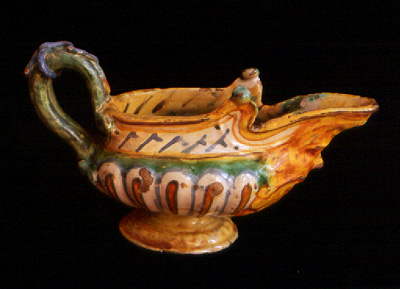The
Ceramic Medium
Making pottery has been a part of human culture almost from the beginning of time, when
simple, unbaked pots were used to store and transport food and water. It was a matter of
pure function--many types of vessels were necessary for simple, utilitarian use. But
somewhere along the way, pottery began to be ornamental, as well. Pot shards from
archaeological sites of almost any era bear the maker's decorations. It's hard to say what
prehistoric potters had on their minds when they embellished their pieces, but current and
historical pieces of pottery provide some clues.

Majolica Sauce Pitcher--16th Century
Urbino --7 inches wide
From the University of Montana Museum of Fine Arts Collection
In 1600, a Japanese ceramist named Raku introduced a new way of glazing and firing clays,
a method that is now known as "Raku." He was responsible for the creation of
cups used for a Japanese tea ceremony that was invested with deep religious meaning. The
clay vessels used were not only functional, but beautiful as well, and the act of making
the pieces was tied to the aesthetic experience of using them.
Rudy Autio, a Montana artist and ceramist, feels that making ceramics pieces should be an
"extension of spiritual experience." Autio, along with Peter Voulkos, became a
resident manager of the Archie Bray Foundation in Helena in 1952. Before that time, the
Bray had been a brick manufacturing company. Archie Bray built a pottery in 1951 to
provide a place for ceramic artists to work.
A workshop held in 1952 with potter Shoji Hamada had a great influence on Autio, and
changed the way he worked with clay. Autio's background was in sculpture, and he had often
made clay models to base sculptures on. From there, he became interested in sculpting the
clay itself. But what he learned from Hamada was not just a technique. It was a different
way of looking at the entire process.
Says Autio, "It became more aesthetic than functional. The process involved much
study and contemplation, and silence and ritual--and an almost Zen philosophy of
acceptance of universal truths." He says that he became less interested in doing
"vessel-oriented" pieces and began to pursue a way of working with clay that was
more a hybrid of pottery and sculpture techniques.
The way that a ceramic piece looks is often related not only to its function, but also to
the process of making it. If the piece is not functional, but purely decorative, the
look of the finished piece has to do only with the process and the imagination of the
creator. Ceramic pieces can be "thrown" on a wheel, or formed by any number of
methods, glazed or unglazed, and fired in different ways to produce any number of kinds of
ceramic ware.
Because the variety of terms used to describe ceramics can become confusing, a few
definitions may be helpful. The word "ceramics" refers to any of various hard,
brittle, heat-resistant and corrosion-resistant materials made by shaping and then firing
a nonmetallic mineral, such as clay, at a high temperature. "Pottery" and
"ceramics" are generally used interchangeably, although sometimes the word
"pottery" is taken to mean a more utilitarian type of ceramics.
Earthenware is a pottery made from porous clay that is fired at relatively low
temperatures. Faience, delft, and majolica are examples of earthenware.
Majolica is tin-glazed earthenware that is often richly
colored and decorated, especially earthenware of this type produced in Italy, or a pottery
made in imitation of this earthenware.
China is high-quality porcelain or ceramic ware,
originally made in China.
Porcelain is a vitreous (glassy), more or less
translucent ceramic ware.
Stoneware is heavy, nonporous, non-translucent pottery, such as jasper ware, that is fired
at high temperature.
Terra Cotta refers to hard, semi-fired, waterproof
ceramic clay, or ceramic wares made of this material.
Anagama is an ancient type of kiln originating in Japan, which uses a wood fire to produce
natural ash glazing.
Raku refers to a method of firing ceramics that results in a distinctive glaze. Raku can
be done with several different techniques.
The basic method for Raku firing involves the use of a glaze that contains copper. Each
piece is fired in a ceramic kiln until it reaches 1800 degrees. At that time, the piece is
carefully removed with long tongs, and placed in a special paper-lined metal can. The heat
from the piece ignites the paper, causing a reaction with the copper in the glaze. This
results in a wide range of colors on the surface of the piece. A lid is put on the can,
and the piece is allowed to cool.
Montana artists produce
all of these types of ceramics, along with numerous others not mentioned here. The work of
many ceramic artists, including Rudy Autio, Peter Voulkos, and Marcy Selsor can be seen at
local galleries and at the Yellowstone Art Museum.
Artists
|| Art Centers || Museums || Galleries
|| Art Resources || Art Supplies |